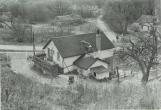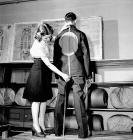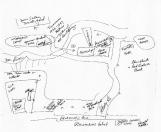1
Sometime in the early 1940s, a prisoner of war camp was established behind the Todmorden Paper Mill.In the 1990s, a number of local residents submitted their memories of the camp to the staff of Todmorden Mills Museum.
Most respondents agreed that the Todmorden camp was small and housed young German merchant seamen.
3
Most respondents also recalled the distinctive uniform worn by the POWs.The uniforms were made of blue or grey denim with a red stripe down the pant legs. Their smock jackets had a large red circle on the back.
4
Prisoner of war camp in the Don Valley, visible in the background at the end of the road1944
Todmorden, Ontario

5
D.B. recalled horseback riding on Pottery Road with her brother in 1943. They saw young POWs in the compound. Sometimes she brought them apples or other food. She was surprised to find out about the camp as it was not publicized officially.J.W.C. remembered the location of the camp and the distinctive uniforms of the prisoners. He thought that security was lax as sometimes the prisoners were taken to the nearby Todmorden Hotel bar. Local residents became unhappy with this situation and camp officials responded by tightening security.
7
As a boy, J.D. and his friends often swam in the Don River north of the Viaduct. One day on the way to the swimming hole they found a collapsible top hat and a broken umbrella in a garbage bin. At the Brick Works, they encountered a group of POWs playing soccer outside the gate. After seeing so many newsreels about Nazis, the boys were surprised to see a group of young men laughing and running about in the open with only a few guards. One prisoner borrowed the top hat and umbrella to do some clowning around.B.L. lived near the Greenwood Clay Pits where the POWs mined the clay used to make bricks. B.L. and his friends would often watch the POWs. The prisoners were guarded by only one man with a rifle. B.L.'s friend had learned some German at Riverdale Collegiate and would shout at them, joking with them or insulting them. According to B.L., the prisoners seemed to take this in good humour.
9
G.S. recalled that the POWs worked at the Greenwood Brick Yard. They were driven there in a small bus, possibly an old Hollinger Bus Lines vehicle. During the winter, when the bus reached the corner of Greenwood and Sammon Avenues, G.S. and his friends would ambush it with snowballs. The boys would leap out and pelt the prisoners with snowballs, shouting "Heil Hitler."G.S. recalled that the prisoners made miniature models of German ships and planes in aspirin bottles. These models were sold or traded with the guards or other local residents.
10
C.P.B. was employed as a dump truck driver at the Toronto Brick in 1945. He worked with 27 German prisoners. He recalled that they had their own cooks who prepared huge hot meals at noon.In about 1960, C.P.B. returned to the brickyard to buy some bricks. He recognized one of the workers as a former prisoner of war who had returned to Canada from Germany.


